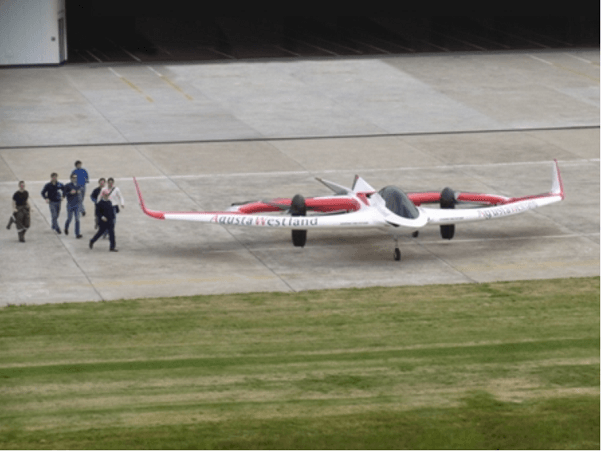VTOLs, or Vertical Take-Off and Landing crafts, are not new. The military utilizes them extensively in operations where aircraft need to get to locations quickly, but the destination either has no landing strip or is isolated, or both. British vertical lift manufacturer AgustaWestland debuted “Project Zero,” an electrically-powered VTOL with much lower carbon emissions than regular VTOL aircraft, earlier this month.
The AgustaWestland Project Zero is a fixed wing aircraft that utilizes a propeller system integrated into each wing. The propellers are set horizontally for vertical take-off and landing like a helicopter, then tilted to more than 90-degrees to provide forward momentum and power like a plane. The wings, of course, provide the lift.

The AgustaWestland Project Zero differs from current fixed-wing VTOLs in its power system. Unlike its brethren, which use conventional gasoline or diesel engines, Project Zero uses an electric motor and rechargeable batteries. This setup effectively makes Project Zero an electric helicopter and airplane with the unique advantages of such crafts. Project Zero does not use air like conventional aircraft , and can be used to fly in higher altitudes or in oxygen-poor environments like over an active volcano. It’s extremely silent, which is useful over cities and in certain military scenarios.
Speaking of the military, the Project Zero motors are thermally “cool,” which make it more difficult to detect by heat sensors. AgustaWestland also simplified the aircraft’s flight control and landing systems, replacing conventional hydraulic ones with electrical versions. Interestingly, Project Zero can recharge its batteries by simply tilting its propellers perpendicular into the wind. The action spins the blades like a turbine and generates the electricity for the batteries.
“This is a wonderful achievement of the AgustaWestland Advanced Concepts Group,” says Dr. James Wang, VP of Research and Technology. “A team of passionate and brilliant engineers worked extremely hard in a secure facility to conceive, design, build and test this technology demonstrator in an exceptionally short period of time. This group lives to dream, and if it can be dreamed, it can be built. The team did not just build an electric powered airplane or helicopter; that would have been too easy. They went all out and built a twin rotor electric tiltrotor with no transmission or swashplates.”
AgustaWestland says it developed Project Zero in less than six months. It has already flown the prototype several times in 2011 and 2012. Both flights were unmanned.